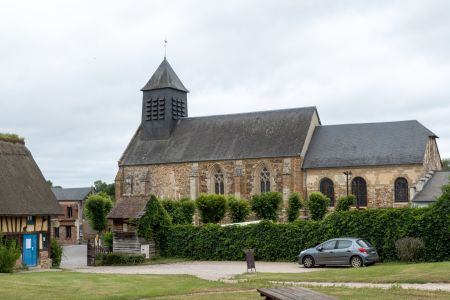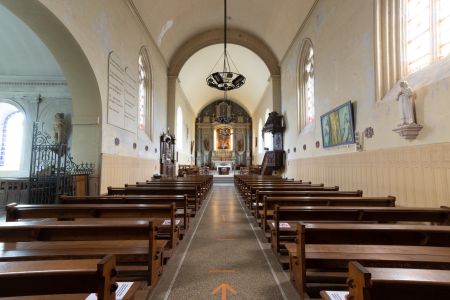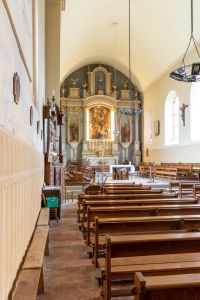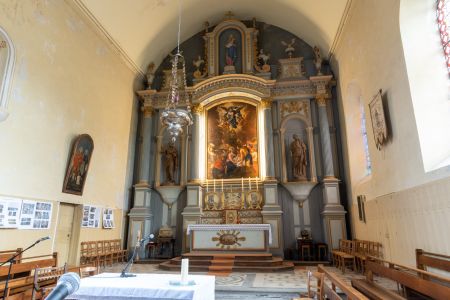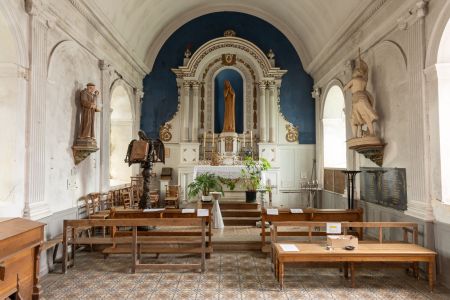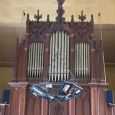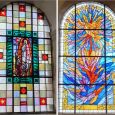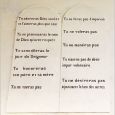Church | XIII - XIV - XVII | Romanesque, Gothic | Catholic Church


Map
Opening hours
01 January - 31 December
Mon 8.00 - 19.00
Tue 8.00 - 19.00
Wed 8.00 - 19.00
Thu 8.00 - 19.00
Fri 8.00 - 19.00
Sat 8.00 - 19.00
Sun 8.00 - 19.00
Photos
Remarkable elements
The high altar and its altarpiece
The altarpiece, created in 1707 by Gilles de Brasnu, comprises four columns, a central painting, "The Adoration of the Shepherds" after Rubens, and two niches containing the stripped wooden statues of Saint Peter to the north and Saint Paul to the south, the parish's patron saints.
The base of the high altar consists of a vast painted and moulded wooden chest, with a central relief decoration on the front.
A tabernacle rests on top of this, its door decorated with a representation of the Mystic Lamb.
Above the tiers are two medallions depicting the profiles of Christ on the left and the Virgin Mary on the right.
Translated with www.DeepL.com/Translator (free version)
The Adoration of the Shepherds
This impressively large painting (3m80x2m50), inspired by both religion and the countryside, is signed "Retous pint 1711".
All eighteenth-century specialists agree on the name Restout, a family of painters from this period, but the exact identity of the author remains a question. Some publications attribute it to Jean Restout (the young), but the painting does not appear in the catalogue of his works. He did paint an "Adoration of the Shepherds", but in 1761.
The most likely explanation is that the painting came from the studio of Eustache Restout. Restout, who was not only an architect, engraver and painter, but also the sub-prior of the Abbey of Saint-Martin de Mondaye (Calvados), was considered to be a copyist, or one who drew inspiration from the works of famous painters (in this case Rubens). He gathered around him a veritable school of art, which was responsible for creating the canvases that were painted under his direction.
Translated with www.DeepL.com/Translator (free version)
The organ
Built by the Damien brothers (organ builders in Gaillon) in response to a request from parishioners to the fabrique (a group of clerics and lay people responsible for administering the parish), it was installed in the church in September 1861.
Construction work began during the summer and involved building a gallery at the back of the church, a case, which is the visible part of the organ, and a carpentry structure in which the pipes and windchests are placed. It has two manuals.
As proof of its solidity, the Sap organ functioned for over a century without undergoing any major repairs. It was not until 1975 that an initial restoration was undertaken, but unfortunately this was abandoned.
It was finally restored in October 1988 by Louis Benoist (organ builder in Laigné-en-Belin). The pipes that had been removed in 1975 and remained on the gallery were reused, so that the organ now looks exactly like the one built by the Damien brothers.
It was listed as a Historic Monument in 1986.
Translated with DeepL.com (free version)
The Annunciation Triptych, by Philippe Gautier
Located on the south wall of the nave and dedicated to the Virgin Mary, it is the work of painter Philippe Gautier, who donated it to the commune.
It consists of three large paintings. In the centre is the Annunciation. The angel Gabriel does not appear in winged human form, but in a burst of sparkling light, giving the painting a predominantly yellow colour. It is surrounded on the left by the Presentation in the Temple and on the right by the Descent from the Cross.
The central picture was painted in 1977, for the international Gemmail competition "Le Prix de la Lumière", of which Philippe Gautier was the winner.
Gemmail takes its name from the contraction of "gem" (precious stone) and "enamel". It is an art form conceived in the 20th century, halfway between painting and stained glass. It was invented by the surrealist painter Jean Crotti around 1935, in collaboration with the physicist Christian Malherbe-Navarre.
The backlighting of this gemmail gives a very luminous vision of the work and enhances the colour.
Translated with www.DeepL.com/Translator (free version)
The stained glass windows
The stained glass window on the right is one of two large windows facing each other in the choir. They were designed and created in 2010 by Florent Chaboissier (1948-), a painter and master glassworker. The glass roof on the south façade was donated by a family from Le Sap.
Next to the south window is a stained glass window donated by the parish and signed by Gérard Bourget (1936-), a master stained glass artist from Saint-Pierre-Église (Manche). This stained glass window was made in 1997 to a design by Nicolas Gautier, then architect of the Bâtiments de France in Orne.
The stained glass window on the left is one of two in the chapel of the Virgin. It was designed by Paul Bony (1911-1982). Bony was the appointed master glassworker of the painter Henri Matisse (1869-1954), in particular for the Rosaire chapel in Vence, but he also worked with other painters such as Marc Chagall (1887-1985) and Georges Rouault (1871-1958).
Translated with www.DeepL.com/Translator (free version)
The statue of Saint Martin
This small statue, 1.32 m high, in painted stone with a Gothic chasuble, dates from the 16th century. It stands near the high altar in a niche on the north wall of the chancel.
It is the only vestige of the Sapmesle (or Sap-Mesle) church, which was destroyed in 1825. Saint Martin was its patron saint, as can be seen from the inscription on its base.
Today, Le Sapmesle is a locality of Sap-en-Auge, following its incorporation into the commune of Le Sap in 1882.
Translated with www.DeepL.com/Translator (free version)
The Decalogue
This open book in relief, as if placed on the north wall of the nave, is a representation of the Tables of the Law, on which are inscribed the Ten Commandments, or "Decalogue", received from God by Moses on Mount Sinai.
A rare sight in churches, it is worth noting this feature.
Translated with www.DeepL.com/Translator (free version)
The lectern with the angel
This 2.25-metre-high painted wooden sculpture, carved from solid wood, dates from the 18th century.
The wrought-iron bookstand was designed to hold an antiphonary (a Catholic liturgical book containing scores of Gregorian chants).
The upper part of the lectern is in the form of a kneeling angel. The stand and base are richly decorated with various motifs, particularly flowers and leaves.
Translated with www.DeepL.com/Translator (free version)




